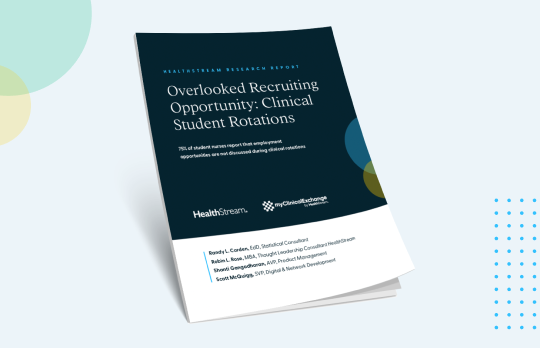
Solutions
-
Learning & Performance
Learning & Performance
-
Learning Management
Learning Management
HealthStream offers performance learning management solutions to help develop your healthcare staff into leaders and reduce turnover.
View All ProductsProducts
-
Video Learning
Video Learning
HealthStream works with healthcare organizations to create engaging and high-quality training videos for your staff and management.
View All ProductsProducts
-
Reporting & Analytics
Reporting & Analytics
Improve care quality and save money by making informed decisions about your healthcare facility and staff with HealthStream's reporting analytics solution.
View All ProductsProducts
-
Performance & Engagement
Performance & Engagement
HealthStream's proven methods for the improvement and overall engagement of your healthcare staff foster a positive workplace and increase retention rates.
View All ProductsProducts
-
Learning Management
-
Quality & Compliance
Quality & Compliance
-
Compliance Solutions
Compliance Solutions
Be confident in your staff’s ability to reduce risk by providing compliance training that changes behavior.
View All ProductsProducts
-
Quality & Safety
Quality & Safety
Develop next-level people for next-level care by prioritizing quality and safety improvements.
View All ProductsProducts
-
Policy Management
Policy Management
Standardize policy and procedure management with an automated, customized, and centralized system.
View All ProductsProducts
-
Culture & Leadership
Culture & Leadership
Establish a culture of belonging with education supporting DEI, wellness, engagement, and leadership development.
View All ProductsProducts
-
Medical Product Training
Medical Product Training
Deliver custom or industry designed product training directly to patient and resident care environments to reinforce proper use.
View All Products
-
Compliance Solutions
-
Reimbursement
Revenue Cycle Education
Streamline the revenue cycle management process and protect your bottom line with expert-backed education.
View All ProductsProducts
-
Resuscitation
Resuscitation
-
Clinical Deterioration
Clinical Deterioration
In all areas of resuscitation, from neonatal to elderly care, clinical deterioration is a risk that can be avoided with the help of HealthStream's training programs.
View All ProductsProducts
-
Resuscitation Solutions
Resuscitation Solutions
Nurture the skills of your nurses and medical staff to help mold them into effective leaders with development training from HealthStream.
View All ProductsProducts
-
Clinical Deterioration
-
Clinical Development
Clinical Development
-
Competency
Competency
Make sure your clinicians have the support they need to provide competent care with clinical competency training and development from HealthStream.
View All ProductsProducts
-
Clinical Quality
Clinical Quality
HealthStream’s learning management system and comprehensive suite of competency management tools empower your healthcare workforce to deliver the best patient care.
View All ProductsProducts
-
Onboarding & Placement
Onboarding & Placement
The suite of healthcare onboarding solutions available from HealthStream aids in nurse retention and improved patient outcomes.
View All ProductsProducts
-
Skills & Decision Support
Skills & Decision Support
Give your healthcare staff the decision support and skills training they need with the online products available from HealthStream.
View All ProductsProducts
-
Professional Development
Professional Development
HealthStream leverages medical professional development in healthcare by providing staff training programs
View All ProductsProducts
-
Acute Care
Acute Care
Create engaging and impactful learning experiences that meet the unique needs of your acute care staff.
View All Products -
Competency Development and Placement
Competency Development and Placement
Unlocking the full potential of clinicians goes beyond aspiration – it’s a commitment we embody. Our competency development solutions help personalize learning for every clinician so you can confidently bridge the gap between theory and practice for your nurse residents while meeting the unique development needs of your seasoned clinician.
View All Products
-
Competency
-
Scheduling
Nurse & Staff Scheduling
Healthcare workforce management is essential. We provide advanced scheduling solutions for organizations to solve issues such as nurse retention
View All ProductsProducts
-
Credentialing
Credentialing
- Provider Credentialing
-
Network Credentialing
Network Credentialing
Tackle all the challenges of provider directory management within a health plan with a single solution tailored to your specific needs.
View All Products -
HealthStream CVO
HealthStream CVO
Our affordable CVO credentialing services establish patient safety by enabling primary source verification for your healthcare organization.
View All ProductsProducts
-
Provider Experience
Provider Experience
Finally, a comprehensive resource to support collecting, storing, and sharing credentialing data with ease.
View All Products -
Provider Validate
Provider Validate
Integrate with Epic to validate and add new providers directly to your provider master file.
View All ProductsProducts
- Industry Rep Credentialing
Solutions powered by ![]()
Learn More.
.png?sfvrsn=3028f62b_0)
Quality Manager formerly known as abaqis®
Mitigate risk and elevate your quality of care. Improving both clinical and business outcomes starts with a smarter, more integrated approach to regulatory training, continuing education and quality management.
Learn MoreNEW TO THE STORE
hStream Content Marketplace
NurseGrid Learn
Practitioner Courses
LATEST & POPULAR

April 11, 2024
April 11, 2024
Recently HealthStream shared results and insights from their first national survey of nursing and clinical students. The research measured respondent perceptions regarding their clinical rotations, interest in employment, and examined ways for hospitals to enhance their recruitment efforts among first-time nurses and clinicians. Results and conclusions from that research were recently shared during a HealthStream webinar. The webinar featured presenters:
- Shanti Gangadharan, AVP, Product Management, HealthStream
- Scott McQuigg, SVP, Digital and Network Development, HealthStream
- Research contributors included:
- Robin Rose, MBA, Healthcare Thought Leadership
- Randy L. Carden EdD, Statistical Analysis
Survey Background
McQuigg began by sharing the survey background. This is likely the first ever national survey of this cohort which included student nurses and clinical students. The research objectives were focused on feedback about their clinical rotation experiences. myClinicalExchange, HealthStream’s secure online workflow application is the nation’s leading application used to connect students, academic institutions and healthcare organizations. myClinicalExchange enrolled 190,000 students into clinical rotations in 2023.
It was from that audience that HealthStream was able to recruit more than 5,100 respondents to complete the survey in December of 2023. 71% of the respondents were nursing students and 75% were graduating within the next 12 months. Respondents were beginning to develop their identities as nurses and clinicians and to develop interest in career opportunities.
As myClinicalExchange has created an efficient means of managing clinical rotations, healthcare leaders can now look to this same solution to help build a pipeline of nursing and other clinical talent. Gangadharan shared the key survey findings.
Missed Recruiting Opportunities
The survey identified some missed recruiting opportunities. 75% of respondents reported that they were not contacted by the organization at any time during or after their most recent rotation. Compounding those missed recruiting opportunities, the survey also found that 75% of the students report that they do not have jobs lined up after graduation which may indicate that they may be amenable to recruitment efforts. Gangadharan shared that additional qualitative research was done to amplify some of the survey results and that one-on-one interviews made it clear that students were open to being recruited. The qualitative research also found that some students are relying on peers for career information which may create additional recruitment pathways.
Students Are Likely to Respond Positively to Recruitment Efforts
A majority (61.5%) of respondents said that they would be interested in working at their rotation site. In addition, more than half (57.2%) of respondents indicated that they would be very likely to accept a job in the department where they did their last rotation
Factor analysis allowed researchers to determine the factors that had the greatest impact on job interest. Respondents who rated staff willingness to provide useful learning experiences highly were more likely to have job interest. Perceptions about how welcoming staff were, how eager they were to support the student, how much they enjoyed the work environment and their likelihood to recommend an area or department were also impactful.
Respondents were also asked which factors were important in selecting a rotation. Topping the list were learning objectives, clinical specialty, travel distance and the organization’s potential as a future employer.
Clinical Rotations Have a Meaningful Impact on Confidence and Competence
Respondents also reported a significant increase in confidence and competence as a result of their rotations which they attributed to exposure to medical concepts, the opportunity to provide hands-on care while building and applying clinical judgement. Fully 97% of respondents report that their confidence in their abilities has either strongly or somewhat increased.
Respondents Valued Their Rotation Experience
Not surprisingly, the majority of respondents (76.2%) would be very likely to recommend the department that hosted their most recent rotation. When asked about their likelihood to recommend their preceptor, the results were even more favorable with fully nine out ten respondents indicating that they would be very likely to recommend their preceptor.
Preceptors are providing an exceptional learning experience. When asked to rate criteria such as willingness to provide learning experiences, creating a welcoming environment, and their eagerness to support the student, students rated each very highly.
Research-Based Recommendations
Based on the research and discussions with leaders from hospitals and schools, McQuigg and Gangadharan shared some recommendations on how to translate these findings into strategy. They shared the following recommendations:
- Create opportunities for students to connect with HR and recruitment teams at the beginning of each rotation.
- Create regular opportunities to connect students with clinicians from different disciplines to broaden their clinical and organizational exposure.
- Be mindful of the fact that you are trying to recruit digital natives. Include QR codes with links to career information in welcome kits, breakrooms, and other handouts to help students connect with both the organization and job opportunities.
- Add opportunities to learn more about career guidance for students completing clinical evaluation processes.
- Consider adding courses that will help students build leadership and job-seeking skills.
- Ask students to rate employment interest when they are evaluating a site or rotation.
- Recognize the great work of preceptors by supporting them with continuing education opportunities, and being mindful of their workloads.

You can watch the on-demand webinar here.
